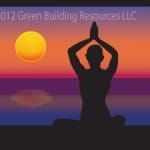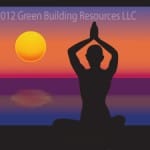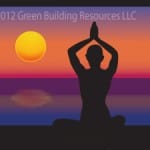
Green Certification Guide
Green Standards & Certifications for Flooring
Standards and certifications on flooring products carried by Natural Interiors® Design Center Members help us determine which products are Better for People, Better for the Planet or both
Here is a rundown on what they mean:
Appalachian Hardwood Manufacturers, Inc. (AHMI) Verified
 This is not a third-party certification, but rather a label from this manufacturers’ trade organization. However, its claims that the Appalachian Hardwood Territory is meeting present timber needs without compromising sustainability are supported by data from the U.S. Forest Service. The U.S. Department of Agriculture’s Forest Inventory and Analysis research has found that trees are growing at a rate of 2.44 to 1 being removed in the 344-county Appalachian Hardwood Region. The net annual growth has been increasing for more than 50 years.
This is not a third-party certification, but rather a label from this manufacturers’ trade organization. However, its claims that the Appalachian Hardwood Territory is meeting present timber needs without compromising sustainability are supported by data from the U.S. Forest Service. The U.S. Department of Agriculture’s Forest Inventory and Analysis research has found that trees are growing at a rate of 2.44 to 1 being removed in the 344-county Appalachian Hardwood Region. The net annual growth has been increasing for more than 50 years.
The Appalachian Hardwood Timber region includes more than 65.7 million acres in the eastern United States, spanning from Georgia to New York.
___________________________________________________________________________________________________________
CA 01350
 Emissions test standards developed by the state of California that apply to many types of flooring, and is used as the basis for some of the indoor air quality certifications listed in this glossary. Specification 01350 defines testing procedures and sets limits for 38 Volatile Organic Compounds (VOCs) that are known to off-gas from products.
Emissions test standards developed by the state of California that apply to many types of flooring, and is used as the basis for some of the indoor air quality certifications listed in this glossary. Specification 01350 defines testing procedures and sets limits for 38 Volatile Organic Compounds (VOCs) that are known to off-gas from products.
___________________________________________________________________________________________________________
CARB Compliant, Phase 1 and Phase 2
 The California Air Resources Board (CARB) implemented standards to improve indoor air quality by tightening limits for formaldehyde emissions from composite wood products. Before January 2009, 0.20 parts per million were allowed.
The California Air Resources Board (CARB) implemented standards to improve indoor air quality by tightening limits for formaldehyde emissions from composite wood products. Before January 2009, 0.20 parts per million were allowed.
Phase 1: Starting in January 2009, the CARB formaldehyde standard was lowered to and average 0.18 parts per million, depending on the type of composite wood product.
Phase 2: In 2012, the CARB formaldehyde standard was lowered again.
The US EPA has adopted the same standards, (in TSCA Title VI), but the final implementing regulations have not gone into effect for manufacturers not in or selling in California. Note: CARB does not set a limit for a laminate or engineered floor. Rather, it sets many different limits for different types of composite wood products as follows:
Hardwood plywood 0.05 parts per million (ppm)
Particleboard 0.09 ppm
Medium-density fiberboard 0.11 ppm
Thin medium-density fiberboard 0.13 ppm
Claiming CARB Compliance requires third-party testing .
Other designations for formaldehyde:
E1
The European standard for formaldehyde emissions that went into effect in 2004, with a limit of 0.14 parts per million.
E0
This standard means that a product contains no added formaldehyde and ensures that emissions do not exceed 0.07 parts per million.
___________________________________________________________________________________________________________
Cradle to Cradle Certification
Administered by the Cradle to Cradle Products Innovation Institute, this is a third-party, multi-attribute certification that assesses a product’s people and planet-friendliness and its design for future life cycles. Materials and manufacturing practices are evaluated in five categories: material health, material reutilization, renewable energy use, water stewardship and social responsibility.
There are four levels of Cradle to Cradle product certification: Basic, Silver, Gold, And Platinum. To be certified at any certain level, the  product must meet the minimum requirements for that level in all five criteria categories.
product must meet the minimum requirements for that level in all five criteria categories.
___________________________________________________________________________________________________________
CRI Green Label Indoor Air Quality Certification
 This standard, now in use only for carpet pad, was created by the Carpet and Rug Institute, a trade organization, but testing and certification is conducted by an independent laboratory. This CRI Green Label standard is not as stringent as the CRI Green Label Plus standard that is used for carpet.
This standard, now in use only for carpet pad, was created by the Carpet and Rug Institute, a trade organization, but testing and certification is conducted by an independent laboratory. This CRI Green Label standard is not as stringent as the CRI Green Label Plus standard that is used for carpet.
The emissions testing for CRI Green Label Certification includes a limit for Total Volatile Organic Compounds (VOCs) and limits for three specific VOCs. One of those is formaldehyde, known to cause cancer. That limit is 50 micrograms per square meter, compared to 30 micrograms per square meter under the CRI Green Label Plus certification. Typical carpet pads are made from materials that include prime polyurethane, bonded polyurethane, mechanically frothed polyurethane, rubberized polyurethane and coated synthetic fiber.
___________________________________________________________________________________________________________
CRI Green Label Plus Indoor Air Quality Certification
 The Carpet and Rug Institute (CRI) has set what some would call strict limits for chemical emissions from carpet. These limits meet or exceed limits set by California standard 01350, which is considered one of the more stringent health-based standards in the country, and is the same standard used by FloorScore certification.
The Carpet and Rug Institute (CRI) has set what some would call strict limits for chemical emissions from carpet. These limits meet or exceed limits set by California standard 01350, which is considered one of the more stringent health-based standards in the country, and is the same standard used by FloorScore certification.
To get certification, a product cannot exceed safety limits set for 13 Volatile Organic Compounds (VOCs) commonly emitted from carpet.
___________________________________________________________________________________________________________
Environmentally Preferable Product (EPP) Certification
 This is a third-party, multi-attribute certification that assesses effects on people and the planet.
This is a third-party, multi-attribute certification that assesses effects on people and the planet.
Products with EPP certification have a reduced negative effect on human health and the environment in comparison to competing products or services that serve the same purpose. This comparison applies to raw materials, manufacturing, packaging, distribution, use, reuse, operation,  maintenance and end-of-life disposal.
maintenance and end-of-life disposal.
__________________________________________________________________________________________________________
Forest Stewardship Council Certification (FSC)
 Considered the most reliable indicator of sustainably harvested wood, FSC remains the only certification to qualify a wood product for credit under the U.S. Green Building Council’s LEED (Leadership in Energy and Environmental Design) rating system.
Considered the most reliable indicator of sustainably harvested wood, FSC remains the only certification to qualify a wood product for credit under the U.S. Green Building Council’s LEED (Leadership in Energy and Environmental Design) rating system.
Superior provisions of FSC include balanced representation in governance that means extra power is not given to those with a purely economic interest in the outcome of a decision. FSC also prohibits the use of hazardous pesticides otherwise widely used and EPA approved – coupled with requirements that protect rivers and other water bodies from erosion and chemical runoff — protect biodiversity in addition to our water supply and human health. Clear-cutting, harvesting old trees and converting natural forests for development sites or tree farms also are prohibited or heavily restricted under FSC.
Certification is offered to companies that demonstrate they can conform to FSC standards in the sourcing, manufacturing, storing, labeling and invoicing of FSC certified material. The material or products can carry a range of claims, including FSC pure, FSC Mix Credit and FSC Mix Percentage.
Note: This, however, does not mean that all products from the certified company are FSC-certified, and as it pertains to hardwood flooring, FSC-certified flooring largely remains a special-order product.
___________________________________________________________________________________________________________
FloorScore Indoor Air Quality Certification
 This certification was started by The Resilient Floor Covering Institute, a trade organization, but the testing and certification is conducted by third-party certifier Scientific Certification Systems. The certification tests chemical emissions from hard-surface, resilient and laminate flooring and is based on California Specification 01350, which sets limits for 38 Volatile Organic Compounds (VOCs).
This certification was started by The Resilient Floor Covering Institute, a trade organization, but the testing and certification is conducted by third-party certifier Scientific Certification Systems. The certification tests chemical emissions from hard-surface, resilient and laminate flooring and is based on California Specification 01350, which sets limits for 38 Volatile Organic Compounds (VOCs).
Note: This certification only measures VOCs and, therefore, does not speak to dioxin or phthalate content in floors with made with poly vinyl chloride.
___________________________________________________________________________________________________________
GREENGUARD Indoor Air Quality Certification
 The GREENGUARD certification program, overseen by the GREENGUARD Environmental Institute, enforces emission limits on 364 VOCs (Volatile Organic Compounds). It also enforces emission limits on the total sum of VOCs that can off-gas from a product. GREENGUARD Certification requires this total VOC limit because health science cannot keep up with the number of new chemical compounds introduced into the marketplace every day.
The GREENGUARD certification program, overseen by the GREENGUARD Environmental Institute, enforces emission limits on 364 VOCs (Volatile Organic Compounds). It also enforces emission limits on the total sum of VOCs that can off-gas from a product. GREENGUARD Certification requires this total VOC limit because health science cannot keep up with the number of new chemical compounds introduced into the marketplace every day.
In addition to flooring, GREENGUARD Indoor Air Quality Certification is used for interior products, including paints and coatings, adhesives and furniture.
Note: This certification only measures VOCs and, therefore, does not speak to dioxin or phthalate content in floors with made with poly vinyl chloride.
___________________________________________________________________________________________________________
GREENGUARD GOLD (formerly known as GREENGUARD Children & Schools) Indoor Air Quality Certification
 Also overseen by the GREENGUARD Environmental Institute, GREENGUARD Children & Schools Indoor Air Quality Certification offers stricter certification criteria. Because developing children are more susceptible to the effects of chemicals, limits set for this certification include a body burden correction factor, making limits more stringent than those listed for GREENGUARD Indoor Air Quality Certification.
Also overseen by the GREENGUARD Environmental Institute, GREENGUARD Children & Schools Indoor Air Quality Certification offers stricter certification criteria. Because developing children are more susceptible to the effects of chemicals, limits set for this certification include a body burden correction factor, making limits more stringent than those listed for GREENGUARD Indoor Air Quality Certification.
With GREENGUARD Children & Schools Certification, the exposure to individual Volatile Organic Compounds (VOCs) has been adjusted to allow no greater than 1/100 of the Threshold Limit Values (TLVs) and no greater than one-half of the California’s Chronic Reference Exposure Levels (CRELs).
Note: GREENGUARD Children & Schools Indoor Air Quality Certification does set limits on total phthalates, consisting of dibutyl (DBP), diethylhexyl (DEHP), diethyl (DEP), dimethyl (DMP), butyl benzyl (BBP) and dioctyl (DOP) phthalates. Phthalates, which are present in flooring and other household items made from poly vinyl chloride, have been linked to endocrine disorders, reproductive and developmental disorders, asthma and allergies.
____________________________________________________________________________________________________________
Green Squared Certification
 Green Squared Certification is an ANSI (American National Standards Institute) standard that recently has gone into use for tile manufacturers.
Green Squared Certification is an ANSI (American National Standards Institute) standard that recently has gone into use for tile manufacturers.
Though concern about tile emitted chemicals has traditionally been low because of natural materials used and high firing temperatures that would burn off organics present in clay or binders, Green Squared has indoor-air quality in addition to sustainability requirements that include a full life-cycle and materials assessment.
 Chemical emissions have to be tested by a third-party certifier – such as Scientific Certification Systems or the GREENGUARD Environmental Institute — and proven to comply with one of three standards, which include California Specification 01350.
Chemical emissions have to be tested by a third-party certifier – such as Scientific Certification Systems or the GREENGUARD Environmental Institute — and proven to comply with one of three standards, which include California Specification 01350.
____________________________________________________________________________________________________________
M1 VOC LABEL
 This is the top-ranking label from The Finnish Society of Indoor Air Quality and Climate (FiSIAQ).Testing for the Scandinavian quality label includes an emission test for ammonia, formaldehyde, and carcinogenics. Products are tested comprehensively for 28 days before the label is awarded.
This is the top-ranking label from The Finnish Society of Indoor Air Quality and Climate (FiSIAQ).Testing for the Scandinavian quality label includes an emission test for ammonia, formaldehyde, and carcinogenics. Products are tested comprehensively for 28 days before the label is awarded.
___________________________________________________________________________________________________________
NSF/ANSI 140 Carpet
 NSF 140 is a multi-attribute sustainability standard for carpet that is lifecycle-based and includes end of life management. Certification is based on point totals to achieve a Silver, Gold or Platinum level.
NSF 140 is a multi-attribute sustainability standard for carpet that is lifecycle-based and includes end of life management. Certification is based on point totals to achieve a Silver, Gold or Platinum level.
This is considered a foremost standard to attest to a carpet’s sustainability. The U.S. General Services Administration now requires all broadloom and carpet tile purchased by the U.S. Government to be certified to NSF International’s Sustainable Carpet Standard (NSF/ANSI 140) gold level.
____________________________________________________________________________________________________________
NSF/ASNI 332 – Resilient Flooring
 NSF 332 is a multi-attribute sustainability assessment for resilient flooring that is lifecycle-based and includes end-of-life management. Certification is based on point totals to achieve a Silver, Gold or Platinum level.
NSF 332 is a multi-attribute sustainability assessment for resilient flooring that is lifecycle-based and includes end-of-life management. Certification is based on point totals to achieve a Silver, Gold or Platinum level.
____________________________________________________________________________________________________________
NWFA Responsible Procurement Program (RPP)
 This certification was developed by the National Wood Flooring Association in conjunction with the U.S. Forest Stewardship Council (FSC); Scientific Certification Systems – a third-party certifier; and the Rainforest Alliance Trees U.S. Program.
This certification was developed by the National Wood Flooring Association in conjunction with the U.S. Forest Stewardship Council (FSC); Scientific Certification Systems – a third-party certifier; and the Rainforest Alliance Trees U.S. Program.
It is designed to enable and measure a wood flooring manufacturer’s ability to produce products that come only from sustainable and socially responsible sources. It also follows a company’s commitment to transitioning to the most stringent levels of environmental responsibility as developed by FSC.
____________________________________________________________________________________________________________
Programme for the Endorsement of Forest Certification Schemes (PEFC)
 Based in Geneva, Switzerland, PEFC is an independent, non-profit organization that promotes sustainable forests through third-party certification. PEFC International bases its criteria on internationally accepted intergovernmental conventions and guidelines, Pan-European Criteria, Indicators and Operational Level Guidelines for Sustainable Forest Management ; and ATO/ITTO Principles, criteria for the sustainable forest management of African natural tropical forests.
Based in Geneva, Switzerland, PEFC is an independent, non-profit organization that promotes sustainable forests through third-party certification. PEFC International bases its criteria on internationally accepted intergovernmental conventions and guidelines, Pan-European Criteria, Indicators and Operational Level Guidelines for Sustainable Forest Management ; and ATO/ITTO Principles, criteria for the sustainable forest management of African natural tropical forests.
____________________________________________________________________________________________________________
SMaRT Certification
 Sustainable Materials Rating Technology or SMaRT, is a multi-attribute sustainability certification recognized by the U.S. Green Building Council’s LEED rating system.
Sustainable Materials Rating Technology or SMaRT, is a multi-attribute sustainability certification recognized by the U.S. Green Building Council’s LEED rating system.
All product life stages are assessed for planet friendliness, in addition to the reduction of more than 1,300 pollutants covering 12 potential environmental impacts. There are four levels of achievement possible, from Sustainable to Sustainable Platinum. The certification is overseen by  MTS, and American National Standards Institute (ANSI)-accredited standards developer. Auditing is conducted by Ernst & Young Global Sustainability.©
MTS, and American National Standards Institute (ANSI)-accredited standards developer. Auditing is conducted by Ernst & Young Global Sustainability.©
____________________________________________________________________________________________________________

